From the Archives ...
Atlantic salmon the hard way
Atlantic salmon the hard way
Scott McDonald
The first Atlantic salmon eggs used to begin Tasmania's Atlantic salmon aquaculture industry were introduced into Tasmania in 1984. From these humble beginnings a valuable Tasmanian industry has evolved with a worldwide reputation for having a premium disease free product. This industry provides a spin off to all anglers in the form of regular escapes of salmon from the farms.
Please check all relevant authorities before fishing - www.ifs.tas.gov.au and dpipwe.tas.gov.au . Don't forget issuu.com/stevenspublishing for years of back issues !
Presented from Issue 99
Early season fishing can be very challenging. Too challenging for this mere mortal of a fishing guide so I don’t like to guide before October. You see, I have a problem taking money from clients for what I consider mostly to be sub-standard (read sub- surface) fishing.
My clients love sight fishing on warm balmy days. Whilst early season shallow water tailers can offer great sport on lake margins and flooded river edges the weather is anything but balmy and the sport is particularly unreliable.
If you are Johnny on the spot, you have good local knowledge of water levels and conditions and you are not scared of frosty, foggy early mornings, then by all means be my guest. You may just find some of the best fishing of the season.
- Written by Stephen Smith - Rubicon Web and Technology Training
- Category: Trout Fishing
- Hits: 4644
Presented from Issue 99
Peter Broomhall’s tips for trout season opening day success on a few of my favourite fisheries
For Tasmanian trout anglers the first Saturday in August is the culmination of a gradual build up in anticipation that started a few weeks beforehand. During this time rods have been checked, reels oiled, lines renewed, leaders retied, hooks sharpened, waders checked for leaks and tackle and fly boxes restocked. In some extreme cases this has been repeated many times over...
- Written by Stephen Smith - Rubicon Web and Technology Training
- Category: Trout Fishing
- Hits: 3939
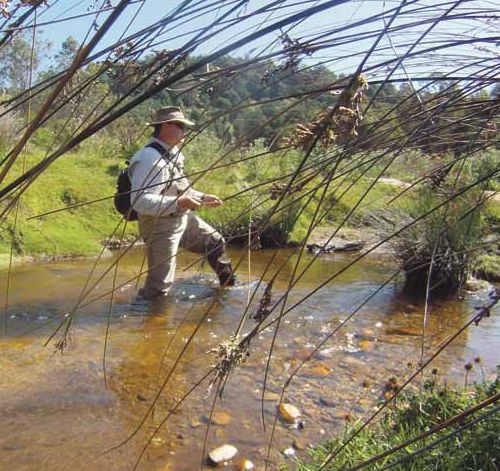 Presented from Issue 99
Presented from Issue 99
For most East Coast anglers the thought of chasing a few trout usually conjures up images of an extended trip to the central highlands, hours of driving, cool temperatures and long hours on the water to make the most of the trip.
However there is some great trout fishing options a lot closer to home than many would think with more than enough variety to satisfy even the most discerning of trout anglers.
With a good mix of river, lake and dam fishing there is something for everyone.
If heading to the rivers my early season recommendations would be definitely some upstream worm fishing in the faster water and small Wattyl Grubs and worms in the slower pools for those wishing to bait fish. A big bunch of scrub worms thread onto a #6 bronze bait holder hook and lobbed unweighted upstream into the tail of runs and eddies is a dynamite technique. If there has been some seasonal rain and the river has broken its banks then its prime time for the worm fisherman, take advantage of the water rising into normally dry drains and into paddocks as the Trout follow and gorge themselves on drowned insects and worms.
- Written by Stephen Smith - Rubicon Web and Technology Training
- Category: East Coast
- Hits: 16536
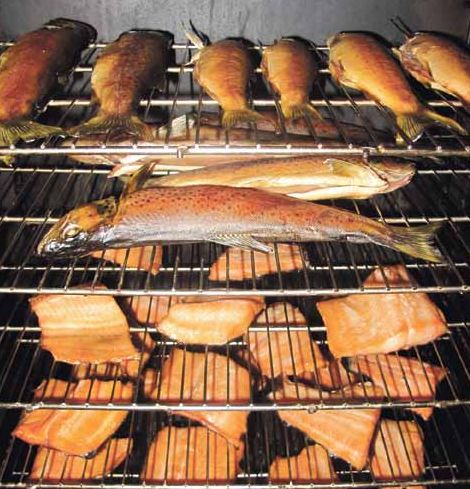 Presented from Issue 99
Presented from Issue 99
I have been smoking fish since I was a child. My European background meant that I learned these skills from an early age, from my father. Using a homemade wood-fired hot smoker, we would smoke eels predominantly, but sometimes trout too. My ‘backyard fish smoking’ apprenticeship lasted for years; however, when I was 12 years old, my father was finally happy to leave me in charge of the whole process.
To this day, I have maintained a keen interest in smoking fish. The only difference is that now, given my keen interest in fishing for them, I primarily smoke trout. Over the years, I have made several homemade fish smokers, and have smoked a variety of fish. In the early days, I stuck religiously to the traditional salt plus water brine; however, in more recent years, I have been experimenting with lots of different brine recipes.
Part of the secret to getting any smoked fish right is the brine. It is the first part of the ‘preserving’ or ‘curing’ process and is a crucial step that cannot be overlooked. Realistically, a simple mix of salt plus water is all that is required to make a basic brine solution. However, there are better recipes out there for those who want to go a step further and make something really special!
- Written by Stephen Smith - Rubicon Web and Technology Training
- Category: Cooking Fish
- Hits: 12496
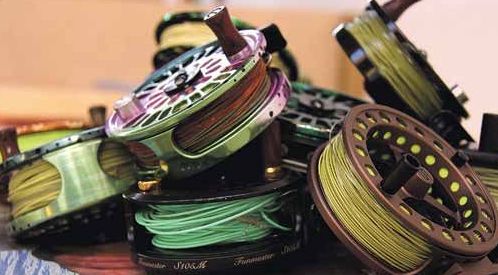 Presented from Issue 99
Presented from Issue 99
I have something to confess, I am a tackle junkie. When it comes to fly fishing gear I try and collect whatever I can, whenever I can. Doesn’t make me very popular at times I must admit but I’m afraid that is just the way it is. My current passion is for collecting different styles of chest/vest packs but I do have a soft spot for a nice reel. A fly reel is probably more important to our kit than a pack lets be honest, you can always throw a box of flies in your pocket if needed and go fishing. But if there is no fly reel locked on to the end of your favourite rod its going to be a tough day on the water!. Over the years I have collected and gotten rid of a fair few fly reels. Some brilliant, some pretty ordinary to tell you the truth.
- Written by Stephen Smith - Rubicon Web and Technology Training
- Category: Fly Fishing
- Hits: 5622
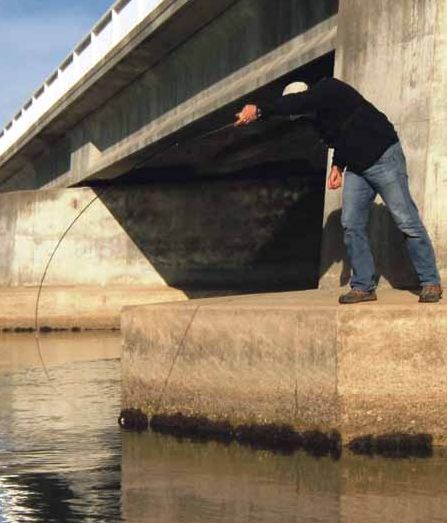 Presented from Issue 99
Presented from Issue 99
The annual spawning run or should I say flood of bream to the Scamander River is well underway. Earlier in autumn small schools of adult fish accumulated around the snags in the lower channel of Georges Bay ready for the long run south. When their numbers built up they made the mad dash down the coast and at times could be seen skirting the rocks of St Helens Point as they went.
Along the way they were joined by fish from Dianas Basin and Wrinklers Lagoon when these lagoons were open to the sea. At the same time fish travelled north from Four Mile Creek and Henderson’s Lagoon massing in the surf at the mouth of the river. At the top of the incoming tide fish moved in through the mouth of the river and gathered around the best two snags the Scamander River has to offer- the bridges. Now in late winter, their destinations are the long stretches of brackish water that will provide the right environment for the food their progeny will need after they hatch.
- Written by Stephen Smith - Rubicon Web and Technology Training
- Category: Bream
- Hits: 11054
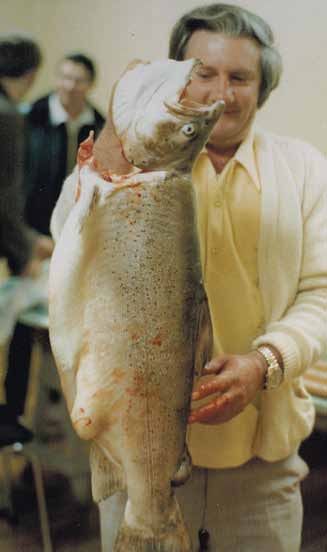 Presented from Issue 99
Presented from Issue 99
Lake Pedder. It used to be a good fishery right? Wrong, it was an exceptional fishery. Through the late 70s and early 80s the trout from this iconic south west water averaged an astonishing 4kg. That was the average weight not the good fish but the average weight. There has never been a fishery like it and there never is likely to be ever again.
What does surprise many is it’s a great fishery now. The trout are nothing like those of years gone by but they are in great condition, fight hard and in numbers that would be astounding if it could ever be calculated. Large bags are common and the quality of fish is very good. So often when it comes up in conversation people are surprised to hear it offers some great fishing to all artificial methods. And most always add that they’ve never been but have always wanted to make the trip out.
It’s well worth it, the scenery alone is unparalleled, panoramas that extend 360 degrees when you’re out on the water. Some areas of the lake it’s breath taking at times. For someone new to the water the fishing possibilities are much the same. You can round a point and be mesmerized by the bay in front of you, flooded tea tree sloping banks into weed rich water, fish rising, sometimes clear of the water chasing damselfly on the wing, only to go around the next point and see it open up again into a better looking bay and another and so on.
- Written by Stephen Smith - Rubicon Web and Technology Training
- Category: Lake Pedder and Gordon
- Hits: 9291
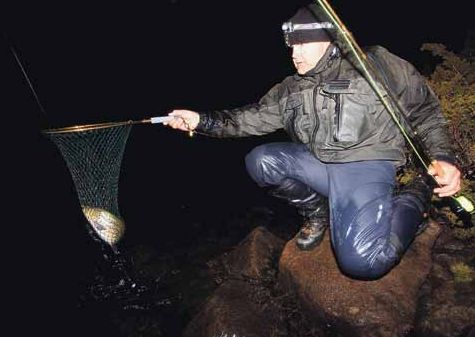 Presented from Issue 99
Presented from Issue 99
The Western Lakes can be a tough place to catch a fish, especially if you’re limiting yourself to sight fishing only. There are many influencing factors that can contribute to seeing very few fish during the day. We see fish in the shallows because there is often some kind of food present that brings them in close to shore. So if there is no food, they really have no reason to leave the security and food rich environment of the deeper water. During low water levels and high water temperatures in late summer, trout will often shelter under rocks during the heat of the day and only venture out late in the evening and into the night to feed. These are the days when you can walk all day and only seen one or two fish.
- Written by Stephen Smith - Rubicon Web and Technology Training
- Category: Western Lakes
- Hits: 5906
If fly fishing is your passion then we need you to help keep the Australian Fly Fishing Museum open.
The Australian Fly Fishing Museum is a unique single subject museum housed at the National Trust Estate at Clarendon just south of Evandale Tasmania about 30 minutes south of Launceston and is open from 10am to 4pm Thursday to Sunday.
The museum houses a collection showing the history of Fly Fishing in Australia and has a well curated display of items which not only deal with the evolution and history, but also the art of fly fishing.
- Written by Stephen Smith - Rubicon Web and Technology Training
- Category: Fly Fishing
- Hits: 4156
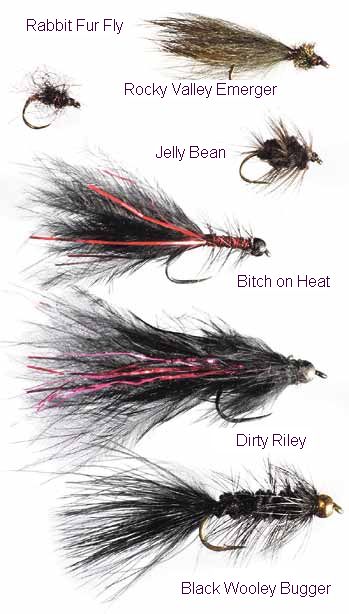 Presented from Issue 99
Presented from Issue 99
The early trout season is always a special time. High water levels with brown trout foraging for a meal close to the edges giving anglers a keenly awaited opportunity for sight fishing, hunting a moving quarry in the shallows as it pushes a bow wave or sends the tip of its tail through the surface as it picks up a morsel off the bottom.
There have been many developments with fly tying materials in recent years, a fly fishing shop contains more glitter and colour than a mardi gras in the fly tying section, but sometimes basic old fashioned patterns which have stood the test of time are the requirement for successful fishing. Flies that are basic in concept and design, simple but representative of life in basic dull natural colours.
- Written by Stephen Smith - Rubicon Web and Technology Training
- Category: Fly Fishing
- Hits: 9031
Subcategories
Current TFBN
Click above for current issue content. The current issue of TFBN is extensive and topical. In Tackle Stores, Newsagents and by subscription.
Delivered to your door for $48 for 2 years (8 issues). To subscribe, send Mike $48 via www.paypal.com.au . (Basic instructions are here) The email is at Contact Us. Your address will be included from PayPal.
Or phone Mike with your c/c handy on 0418129949
Please ensure your details are correct, for Mike to organise delivery.
TFBN Newsletter Sign up Form
Why not submit an article ?
When you have finished for the day, why not have a brag about the ones that didn't get away! Send Mike an article on your fishing (Click here for contact details), and we'll get it published here. Have fun fishing - tasfish.com
Category Descriptions
Here is a list of all of the Article Categories. The number in Brackets, eg (13) is the number of articles. Click on Derwent River and all articles relating to the Derwent will be displayed in the central area.
Articles by Category
-
Rivers (3)
-
Saltwater and Estuary Fishing (149)
-
Kayak Fishing (34)
-
Lakes (1)
-
Great Lake (62)
-
Lake Leake (52)
-
Woods Lake (16)
-
Lake Augusta (11)
-
Huntsman Lake (13)
-
Lake Pedder and Gordon (10)
-
Lake Dulverton (5)
-
Lake Crescent (6)
-
Tooms Lake (10)
-
Lake Mackintosh (2)
-
Lake Barrington (5)
-
Little Lake (8)
-
Meadowbank Lake (5)
-
Lake King William (7)
-
Lake St Clair (2)
-
Western Lakes (12)
-
Arthurs Lake (35)
-
Lake Echo (7)
-
Four Springs (54)
-
Lake Sorell (7)
-
Lake Burbury (6)
-
Other Lakes (57)
-
Brushy Lagoon (18)
-
Little Pine Lagoon (5)
-
Penstock Lagoon (16)
-
Brumbys Creek (7)
-
-
Events (48)
-
Estuary Fishing (0)
-
Coastal Catches (46)
-
Super Trawler (46)
-
IFS, DPIPWE, MAST and Peak Bodies (435)
-
Commercial Interests (98)
-
Other (24)
-
TFBN Back Issues (8)
-
Fly Fishing (67)
-
Trout Fishing (250)
-
Meteorology and Weather (8)
-
Jan’s Flies (50)
-
Tuna Fishing and other Game Fishing (86)
-
Cooking Fish (19)
-
Fishing Information (1)
-
Fishing Books (8)
-
Videos (5)
-
Tackle, Boats and other Equipment (146)
-
World Fly Fishing Championship 2019 (2)
Popular Tags
windyty.com
Visit https://www.windyty.com/
Rubicon Web and Technology Training
Hello everyone, I thought it would be a good time to introduce myself.
My name is Stephen Smith and I have been managing the website tasfish.com since May 2009.
It has been an epic journey of learning and discovery and I am indebted to Mike Stevens for his help, support and patience.
I am developing a new venture Rubicon Web and Technology Training ( www.rwtt.com.au ). The focus is two part, to develop websites for individuals and small business and to train people to effectively use technology in their everyday lives.
Please contact me via www.rwtt.com.au/contact-me/ for further information - Stephen Smith.
From the Archives ... (last chance)
Sea runners - Early Season Excitement - Christopher Bassano
Presented from Issue 100
Considering the world class quality of our sea trout fishery, these fish are not sought after by enough anglers. Sea runners live in the salt water and run up our estuaries and rivers from the start of August to the middle of November. At this time of the year, they are here to eat the many species of fish that are either running up the rivers to spawn or are living in and around the estuary systems. Trout, both sea run and resident (Slob Trout) feed heavily on these small fish which darken in colouration as they move further into fresh water reaches.
The majority of these predatory fish are brown trout with rainbows making up a very small percentage of the catch. They can be found all around the state but it would be fair to say that the east coast is the least prolific of all the areas. They still run up such rivers as the Georges (and many others) but their numbers along with the quality of the fishing elsewhere make it difficult to recommend the area above the larger northern, southern and western rivers.
Read more ...


